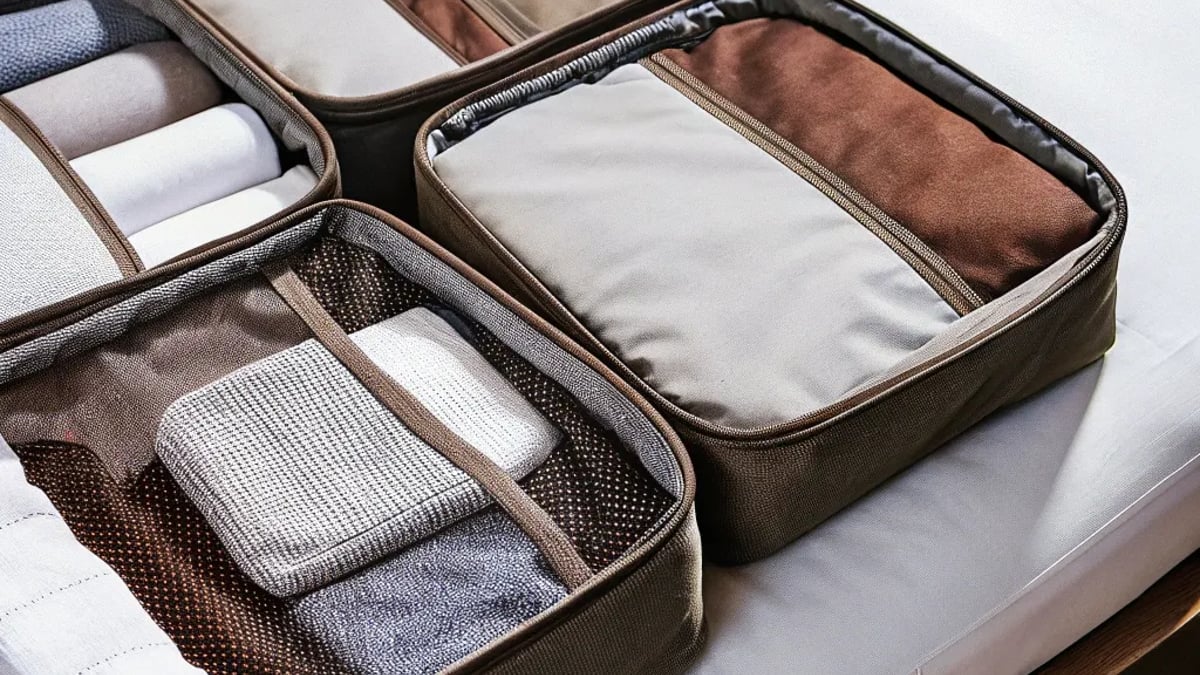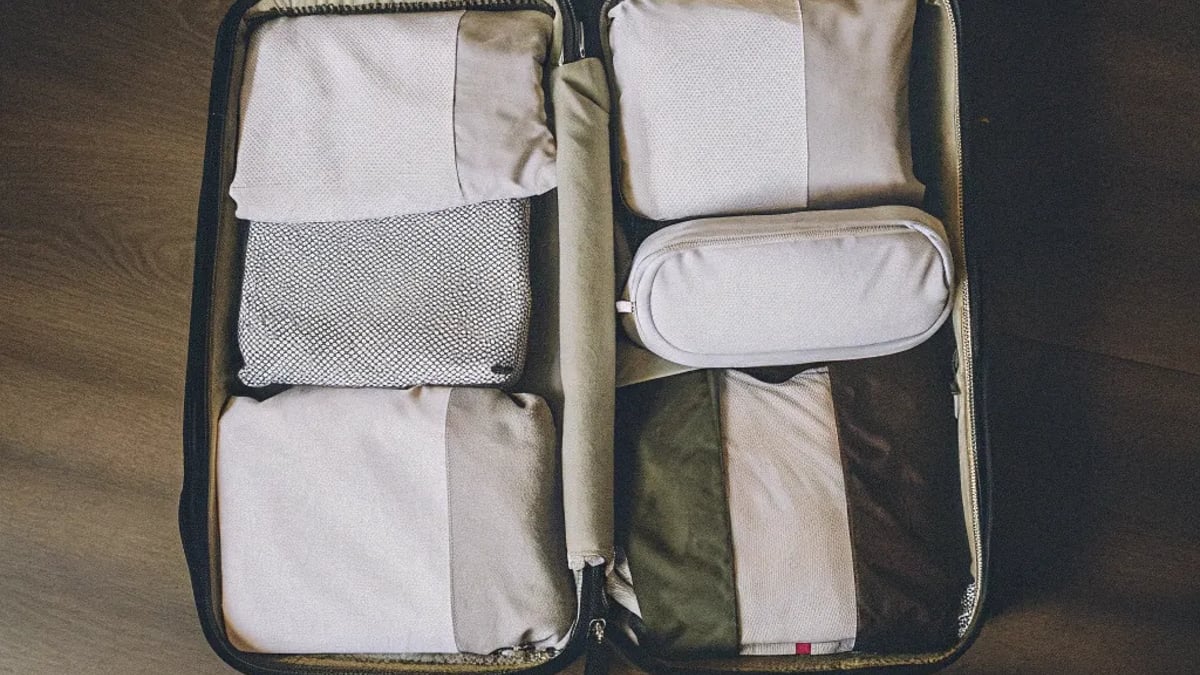
Anyone who's wrestled with an overstuffed suitcase knows the struggle. You've got everything laid out perfectly at home, but somehow it all expands the moment you try to pack it. After years of sitting on suitcases and using the "roll and pray" method, I finally decided to test whether packing cubes actually deliver on their space-saving promises.
Do Packing Cubes Really Save Space or Just Organize?
This question divides travelers more than you'd expect. On Reddit's r/onebag community, debates rage about whether cubes are worth the investment or just another gimmick.
The truth? It depends entirely on the type of cube and how you use it. Standard packing cubes primarily organize your belongings, keeping shirts with shirts and socks with socks. But compression packing cubes—those with additional zippers that squeeze everything down—genuinely create more space.
One Reddit user reported their compression cubes reduced volume by 67%, which matches my experience testing several brands. The math makes sense: fabric compressed with mechanical force simply occupies less space than loosely folded items.

However, there's an interesting counter-movement gaining traction. A post titled "I tried 'no packing cubes' and my god, it does actually save more space" received significant attention. The poster found that strategic loose packing allowed clothes to conform to odd spaces in their bag. This works particularly well for irregular shaped bags or when packing minimal clothing.
So which approach is right? Let's dive into the best options for both camps.
Compression Cubes That Actually Deliver
After testing dozens of brands across three continents (and one particularly chaotic business trip to Bangkok), these compression cubes consistently outperformed the competition:
Eagle Creek Pack-It Compression Cubes
Eagle Creek has perfected the compression mechanism with their dual-zipper system. The first zipper closes the cube normally, while the second applies compression, reducing volume by approximately 40%.

What sets these apart is the mesh top that allows you to see contents without opening, and the surprisingly durable construction. During my tests, these compressed a week's worth of t-shirts down to about the size of a hardcover book.
The medium size measures 10 × 14 × 3 inches expanded but compresses down to just 10 × 14 × 1 inch. That's 66% less volume!
One drawback: at around $40 for a set of three, they're pricier than basic options. But considering they've survived 15+ trips without a broken zipper or torn seam, the investment makes sense.
Gonex Compression Packing Cubes
If Eagle Creek's price point makes you wince, Gonex offers impressive performance at roughly half the cost. Their compression cubes use a similar dual-zipper system that reduces volume by about 30-35%.
What impressed me was how the nylon material strikes a nice balance between lightweight and durable. During testing, I packed 5 dress shirts and 2 pairs of pants in the large cube, compressed it, and still had room for my running shoes alongside it in my carry-on.
Each cube in the set measures approximately 9 × 13 × 4 inches expanded and compresses down to 9 × 13 × 2 inches. While the 50% volume reduction isn't as dramatic as Eagle Creek's, the price-to-performance ratio is excellent.
The only notable weakness is slightly less durable zippers—be gentle when compressing fully packed cubes.
Peak Design Packing Cubes
For the design-conscious traveler, Peak Design's compression cubes offer a more sophisticated approach. Rather than using a compression zipper, these feature a unique "tear-away" zipper that expands or contracts the cube's volume.
The standout feature is the separate compartments for clean and dirty clothes, which proved incredibly useful during a two-week trip through humid Southeast Asia. The weatherproof nylon shell also protected my clothes during an unexpected downpour in Vietnam (my backpack wasn't as waterproof as advertised).
These compress about 35% when fully loaded, which isn't class-leading, but the thoughtful design features compensate for slightly less compression.
The medium size measures 12.6 × 6.7 × 3.4 inches expanded and compresses to approximately 12.6 × 6.7 × 2.2 inches. At $30-40 per cube, they're definitely a premium product, but one that delivers value through smart design rather than just raw compression power.
Organizational Cubes Worth Considering
If organization is your primary concern with space-saving as a secondary benefit, these options excel:
Shacke Pak Organizers
These don't compress per se, but their thoughtful sizing and durable construction make them perfect for maximizing suitcase space through better organization.
The five-piece set includes four different sizes plus a laundry bag, allowing you to perfectly tetris your belongings. The X-shaped reinforcement on top prevents bulging, which means they stack beautifully in a suitcase.
During testing, I found I could fit about 30% more clothing in my carry-on by using these cubes compared to my previous haphazard packing method. Not because they compressed anything, but because they eliminated wasted space.
The largest cube measures 17.5 × 12.75 × 4 inches, which perfectly fits along one side of a standard carry-on. At around $30 for the set, they offer excellent value.
Bagail Packing Cubes
Bagail's 6-piece set stands out for including specialized shapes beyond the standard rectangle. The set includes slim cubes perfect for toiletries or electronics, which fit neatly into awkward spaces in your luggage.
The mesh tops allow for breathability and visibility, while the handles make them easy to grab from a fully packed suitcase. Last Tuesday, I used these to pack for a weekend wedding and was surprised how the various sizes allowed me to utilize every inch of my weekender bag.
While they don't compress, the thinner material allows them to conform somewhat to available space, making them more flexible than rigid organizers. A full set costs around $25, making them one of the most affordable options that doesn't sacrifice quality.
Specialty Organizers That Create Space
Beyond traditional packing cubes, specialty organizers can dramatically increase your packing efficiency:
Osprey Ultralight Packing Cube Set
For hikers and ultralight travelers, every gram matters. Osprey's ultralight cubes weigh just 2.3 ounces for the large size (compared to 8+ ounces for standard cubes), yet still provide decent organization.
The silnylon material is surprisingly strong despite its thinness, and the zippered mesh top provides visibility. While they don't actively compress, their minimal structure allows them to conform to irregular spaces in a backpack.
I used these during a 10-day hiking trip in Colorado, and they kept my limited clothing organized while adding virtually no weight. They're not as durable as heavier options, but for weight-conscious travelers, they're unbeatable.
A set of three weighs less than a single standard packing cube but costs around $40—you're paying for the ultralight materials and construction.
Compression Sacks for Bulky Items
For winter travel or outdoor adventures, compression sacks designed for sleeping bags work wonders on bulky clothing. Sea to Summit's compression sacks use straps rather than zippers to reduce volume, creating significantly more compression than standard cubes.
I managed to compress a puffy winter jacket, two sweaters, and a fleece into a package about the size of a football. The downside? Items come out extremely wrinkled, so this works best for casual clothing or outer layers.
These range from $25-35 depending on size and can reduce volume by up to 70% for compressible items like down jackets or synthetic layers.
How to Actually Save Space: Techniques Matter
Having the right cubes is only half the battle. How you use them dramatically affects their space-saving potential:
The Rolling Method
Rolling clothes before placing them in compression cubes creates significantly more space than folding. In my tests, rolling reduced volume by about 20% on its own, and when combined with compression cubes, I achieved nearly 50% total reduction.
The technique is simple:
- Lay garments flat
- Fold in the sleeves/sides
- Roll from bottom to top, as tightly as possible
- Place rolled items side by side in the cube
This works particularly well for t-shirts, pants, and casual dresses. Dress shirts and blazers, however, should still be folded to minimize wrinkles.
The Bundle Method
For travelers who prefer not using cubes, the bundle method is worth considering. It involves wrapping smaller items inside larger ones, creating a compact bundle that minimizes wrinkles and maximizes space.
Start with a core of small items like socks and underwear, then layer larger items around them in order of increasing size and decreasing wrinkle-proneness. The final bundle conforms well to irregular spaces in luggage.
In my experience, this method saves about 15-20% space compared to traditional folding, but requires more time and planning than using cubes.
When Packing Cubes Don't Help
Despite their benefits, packing cubes aren't always the answer:
Rigid Items and Odd Shapes
Compression cubes work best with soft, flexible clothing. They do nothing for shoes, toiletry bottles, or electronics. For these items, dedicated organizers or strategic placement directly in your luggage works better.
Already Efficient Packing
If you're already an efficient packer with minimal clothing, adding cubes might actually reduce your efficiency. The material of the cubes themselves takes up space, so extremely light travelers might do better without them.
Ultra-Budget Travel
While budget options exist, quality compression cubes represent an investment. If you rarely travel or are on an extremely tight budget, learning efficient folding techniques might be more economical.
What About Vacuum Storage Bags?
Vacuum or space bags use air removal rather than mechanical compression. They create dramatic space savings—up to 80% for fluffy items like sweaters or jackets—but come with significant drawbacks.
First, they require access to a vacuum for the return journey. Second, they create extremely wrinkled clothing. And third, they're prone to leaking air during transit, which can leave you with expanded bags mid-journey.
I've found them useful for seasonal storage at home but rarely practical for actual travel. The exception might be one-way trips or moving between homes, where the dramatic compression outweighs the inconveniences.
Making the Right Choice for Your Travel Style
The best packing solution depends entirely on your travel style:
- Business travelers benefit most from organizational cubes that minimize wrinkles while keeping outfits separate and accessible.
- Backpackers and adventure travelers should invest in quality compression cubes to maximize limited backpack space.
- Minimalist travelers might skip cubes entirely and use the bundle method or strategic loose packing.
- Family travelers often find a mix works best—compression cubes for clothing and specialized organizers for smaller items like kids' toys or toiletries.
After testing countless combinations across dozens of trips, I've settled on a hybrid approach: compression cubes for clothing, a dedicated shoe bag, and strategic loose packing for oddly shaped items.
Final Thoughts: Are They Worth It?
After all this testing and traveling, my conclusion is clear: quality compression packing cubes genuinely save space when used correctly. The 30-50% volume reduction they provide can mean the difference between checking a bag and carrying on, or between struggling with an overstuffed backpack and having room for souvenirs.
However, the organizational benefits might actually outweigh the space savings. Being able to quickly find specific items without unpacking everything—especially in shared accommodations or on multi-destination trips—reduces travel stress significantly.
Like most travel gear, the best solution isn't universal but personal. Experiment with different methods, find what works for your specific needs, and remember: the best packing system is the one that lets you focus less on your luggage and more on your journey.
What's your experience with packing cubes? Have you found they save space, or are they just another travel gadget? Let me know in the comments!
Tags

About Fiona Marwick the Author
Fiona Marwick is a seasoned travel gear expert with over 15 years of experience in reviewing and recommending the best seasonal equipment. Her deep passion for outdoor adventures and meticulous attention to detail make her insights invaluable for those seeking reliable gear for any time of year.
Recommended Articles
These Holiday Ornaments Are Now in Demand at Auction
Discover why vintage holiday ornaments are trending at auctions, driving collector demand for nostalgic and valuable seasonal decor.
Take the Grand Tour of Italy by Scenic Train
Experience Italy's stunning landscapes on scenic trains. Discover picturesque routes, culinary delights, and cultural immersion with our comprehensive guide.
7 Colorful Cardigans That Are Lifting Seniors’ Spirits
Discover 7 colorful cardigans designed to uplift seniors' spirits with style, warmth, and comfort for any occasion.
5 Cancelled Shows That Came Back Stronger
Discover five cancelled shows that made a comeback, thriving on fan support and evolving narratives to captivate audiences anew.
The Pillow That Keeps Going Viral for Neck Relief—Too Good to Be True?
Explore the viral neck pillows promising relief. Discover their effectiveness based on user experiences and expert opinions in this comprehensive review.




